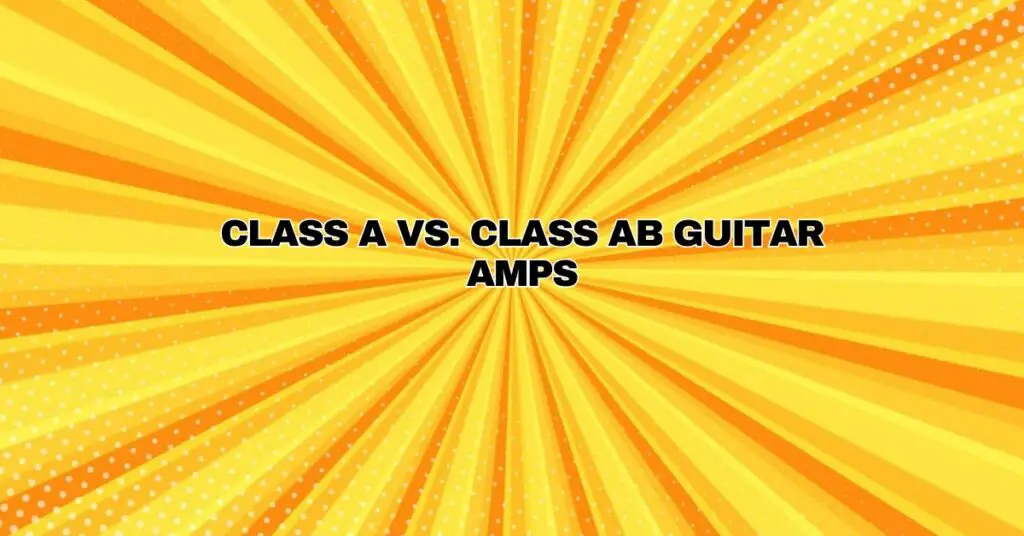When it comes to amplifying the sound of an electric guitar, the choice of amplifier can significantly impact the tone and character of the instrument. Among the many amplifier types available, Class A and Class AB amps stand out as popular choices among guitarists. In this article, we will explore the differences between Class A and Class AB guitar amplifiers, their respective advantages and disadvantages, and how these factors affect the tonal landscape for musicians.
Understanding Class A and Class AB Amplifiers
Before diving into the comparison, it’s crucial to understand the basic operating principles of both Class A and Class AB amplifiers:
Class A Amplifiers:
- Class A amplifiers conduct current through their output transistors continuously, regardless of the input signal. This means that the output transistors are “on” all the time, which results in a constant power draw and significant heat generation.
- Class A amplifiers are known for their linearity and low distortion, making them popular among audiophiles and guitarists seeking a warm and pure tone.
- They are typically lower in power output and less efficient than Class AB amplifiers.
Class AB Amplifiers:
- Class AB amplifiers combine elements of both Class A and Class B amplifiers. They conduct current through their output transistors partially, reducing power consumption and heat generation compared to Class A.
- Class AB amplifiers offer improved efficiency and can provide higher power outputs, making them versatile for various musical styles and performance settings.
- They may introduce a small amount of crossover distortion when transitioning between the positive and negative halves of the waveform.
Advantages and Disadvantages of Class A Guitar Amps:
Advantages:
- Pure and Warm Tone: Class A amplifiers are cherished for their pure, warm, and harmonically rich tone. They offer excellent clarity and a “singing” sustain that is favored by many blues and classic rock guitarists.
- Smooth Distortion: Class A amps often produce a smooth and gradual distortion as the volume is cranked up, leading to musical and expressive overdrive.
- Sonic Character: The continuous operation of Class A amps imparts a unique sonic character that some players find addictive and immersive.
Disadvantages:
- Inefficiency: Class A amplifiers are highly inefficient and generate a significant amount of heat. This limits their power output and makes them less suitable for high-volume or gigging scenarios.
- Lower Power: Class A guitar amps typically offer lower power outputs, which may not be sufficient for certain musical genres or large venues.
Advantages and Disadvantages of Class AB Guitar Amps:
Advantages:
- Versatility: Class AB amplifiers offer versatility in terms of both power and tone. They can deliver clean, crisp tones at lower volumes and provide high-gain distortion when pushed.
- Efficiency: Class AB amps are more efficient than Class A, resulting in less heat generation and longer tube life.
- Ideal for Gigging: The higher power output of Class AB amps makes them well-suited for live performances in larger venues.
Disadvantages:
- Crossover Distortion: Class AB amplifiers may introduce a small amount of crossover distortion when transitioning between the positive and negative halves of the waveform. However, modern designs have minimized this issue.
- Tonal Complexity: Some players argue that the tone of Class AB amps can be less pure and harmonically rich compared to Class A amps.
Conclusion
The choice between Class A and Class AB guitar amplifiers ultimately depends on a guitarist’s preferences, playing style, and performance requirements. Class A amplifiers offer a pure, warm, and harmonically rich tone that many players find captivating, making them ideal for blues and classic rock genres. However, they may be less practical for high-volume gigs due to their lower power output and inefficiency.
On the other hand, Class AB amplifiers provide versatility, efficiency, and higher power outputs, making them suitable for a wide range of musical styles and performance settings. While they may introduce minimal crossover distortion, modern designs have largely addressed this issue, allowing players to enjoy a wide tonal palette.
Ultimately, the tonal landscape in the realm of guitar amplifiers is diverse and rich, offering options that cater to the unique sonic preferences and needs of every guitarist. The choice between Class A and Class AB amplifiers is just one of the many decisions musicians make on their quest to unleash their desired tone.


